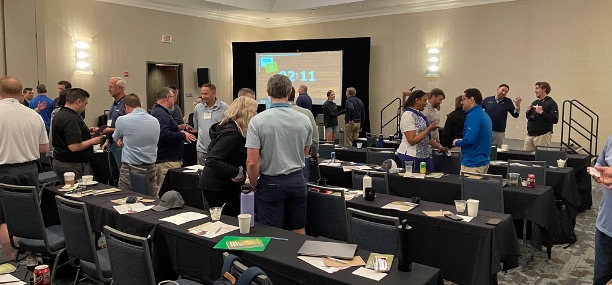If you want better collaboration in your organization, start with relationships.
Every productive conversation, every shared idea, every bit of feedback, all depends on one thing: trust. And trust doesn’t show up just because people share a job title or department.
It shows up because people have shared context.
They know each other. They’ve connected.
If your organization wants to improve performance through more collaboration across teams or departments, you need to stop assuming people will do that naturally.
Thankfully, you can boost trust, idea sharing, and accountability with this simple weekly habit.
You just need to engineer connection before you expect collaboration.
In this article, you’ll discover a deceptively simple strategy that can help your people build the kind of relationships that make real collaboration happen.
It’s the kind of tactic you’ll find in my book, What Effective Leaders Do, which outlines clear and specific actions leaders can take to strengthen awareness, build trust, and accelerate team performance.

Why Relationships Are the Root of Real Collaboration
Every organization says they want collaboration — but they often skip the necessary ingredient: connection.
Without relationships, collaboration is just coordination. People only share what’s required. They withhold what’s inconvenient or risky.
But when there’s trust, people don’t just share tasks… They share ideas, struggles, and feedback.
If you want a Sticky Culture where people stick around, stick to shared values, and stick their necks out to support others — you need to create space for connection to grow.
One simple and effective way to do that is by starting a weekly habit called Connection Chats.
These are 15-minute, no-agenda, virtual or in-person conversations between two people who don’t normally interact. The goal isn’t productivity… it’s proximity.
Emotional, human, and conversational proximity.
It’s an easy-to-implement tool that aligns with one of the key truths in What Effective Leaders Do: you can’t lead people well unless you understand them.

Why Connection Chats Drive a More Collaborative Culture
1. Engineer Unstructured Connection Experiences
Your people won’t accidentally get to know the people they depend on, or who depend on them.
You need to create opportunities for conversation without a task list.
That’s where Connection Chats make a difference.
How to implement them:
- Use a simple tool or spreadsheet to randomly pair teammates from different roles or departments each week.
- Schedule a recurring 15-minute block on both participants’ calendars.
- Offer a few prompt questions (see below), but stress that there is no agenda beyond learning about each other.
This small habit helps build bridges that strengthen team awareness — a critical ingredient for collaboration that I emphasize in the book.
2. Model the Value of Curiosity
People are more likely to participate when they see leaders modeling the behavior. If you don’t value curiosity, they won’t either.
As a leader, demonstrate:
- Active participation in Connection Chats.
- Follow-up actions that show what you’ve learned about teammates across departments.
- Public appreciation of how informal connections have led to improved communication or cooperation.
This reinforces insights from the book What Effective Leaders Do – because all leadership is the influence of our intentional interactions on others.
3. Make Feedback and Idea Sharing Easier by Building Context
People often hold back feedback or ideas because they fear it won’t be received well. That’s a relational gap, not a strategic one.
Connection Chats shrink that gap.
Ways to build that context:
- Share 2-3 optional prompt questions before each chat (e.g., “What’s something your team is working on that others might not realize?” or “What’s a common misconception about your role?”).
- Encourage listening over fixing.
- After 4-6 weeks, invite participants to share a key insight they gained that shifted their understanding of another team or role.
Greater understanding leads to greater generosity — and better input.
4. Reinforce Accountability Through Empathy
Accountability isn’t about pressure — it’s about pride in partnership.
People are far more likely to meet expectations (and help others meet theirs) when they feel a sense of connection.
To reinforce this as a leader:
- Connect team objectives to the relationships that support them.
- Recognize moments when cross-functional cooperation made a difference.
- Use team meetings to celebrate relational wins, not just performance metrics.
This is another concept explored in What Effective Leaders Do: empathy isn’t a soft skill. It’s the fuel for trust, accountability, and sustained performance.
5. Create a Culture Where Conversations Are Continuous
Hosting one “team building day” and expecting lasting change is wishful thinking.
Yes – team building events can have a significant impact on the awareness and attitudes of your team members…
But connection needs to be a rhythm — not a retreat event only.
To create that rhythm:
- Keep the Connection Chats going — weekly or biweekly — with rotating pairings.
- Include people at all levels of the organization.
- Keep it light, human, and consistent.
Remember, you’re not just encouraging interaction — you’re embedding a behavior that supports long-term cultural health. And the leaders who consistently build that culture are the ones who attract and keep top talent.
And whether you call them “connection chats” or not, the most important thing is that you start them as a program in your organization – and stay consistent.

COLLABORATION IS THE CANARY IN YOUR CONFFERENCE ROOM
Want to know how healthy you culture is?
Pay attention in your next team meeting. Are people sharing suggestions? Mistakes? Feedback? If not, that lack of collaboration is a powerful sign that your team needs to feel safer and more connected.
Better collaboration isn’t built on policies — it’s built on people.
And people collaborate best when they know, understand, and trust each other.
If you want more effective teamwork, better feedback loops, and a culture of accountability and innovation, you need to start with connection.
That’s what Connection Chats deliver — and it’s just one of the many simple, actionable strategies I share in What Effective Leaders Do. If you found this idea helpful, the book includes dozens of other tools and tactics to help you develop both your leadership and your team’s performance.
And if you’d like to go further — and create a memorable, impactful experience for your team — let’s connect.
– – – – –

Sean Glaze is a sought-after leadership and workplace culture speaker, who gained valuable insights on turning talent into teamwork as a successful basketball coach – and now he travels around the country to share those actionable lessons.
Sean’s engaging conference leadership keynotes and custom team building programs have helped clients like Cisco, John Deere, the CDC, and Emory University to increase collaboration, boost productivity, and build Sticky Cultures that inspire more profitable teamwork.
Sean’s books, Rapid Teamwork, What Effective Leaders DO, The 10 Commandments of Winning Teammates, and Staying Coachable are entertaining parables that accelerate the growth of leaders and teams!

Effective Leaders Build Trust and Teamwork by Focusing on Leadership Development

The Power of a Sticky Culture in Boosting Organizational Performance and Retention

Are Your Team Standards Seen as Suggestions or Recognized as Requirements?

The Difference Between Being Trust-Willing and Trustworthy in Boosting Team Performance
Books and Resources for Leaders
Check other blog
Effective Leaders Build Trust and Teamwork by Focusing on Leadership Development
The Power of a Sticky Culture in Boosting Organizational Performance and Retention
Are Your Team Standards Seen as Suggestions or Recognized as Requirements?
Contact Sean

Connect with Sean

Tell Sean About
Your Event
Tell Sean About
Your Event
"*" indicates required fields










